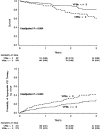Risk stratification using heart rate turbulence and ventricular arrhythmia in MADIT II: usefulness and limitations of a 10-minute holter recording
- PMID: 15245344
- PMCID: PMC6932719
- DOI: 10.1111/j.1542-474X.2004.93600.x
Risk stratification using heart rate turbulence and ventricular arrhythmia in MADIT II: usefulness and limitations of a 10-minute holter recording
Abstract
Background: We evaluated the usefulness of heart rate turbulence (HRT) parameters and frequency of ventricular premature beats (VPBs) for risk-stratifying postinfarction patients with depressed left ventricular function enrolled in Multicenter Automatic Defibrillator Trial II (MADIT II).
Methods: In 884 MADIT II patients, 10-minute Holter monitoring at enrollment was used to evaluate HRT parameters and frequency of VPBs. The primary endpoints were defined as all-cause mortality in patients randomized to conventional treatment and as appropriate therapy for ventricular tachycardia or fibrillation in patients randomized to implantable cardioverter defibrillator (ICD) therapy.
Results: The median turbulence slope was lower in patients who died in comparison to survivors in the conventional arm (2.3 vs 4.5 ms/RR; P < 0.05); but it was not a significant predictor of mortality after adjustment for clinical covariates (age, ejection fraction, beta-blocker use, and BUN levels). There was no association between HRT parameters and arrhythmic events in ICD patients. Conventionally treated patients who died and ICD patients who had appropriate ICD therapy had significantly more frequent VPBs than those without such adverse events. After adjustment for clinical covariates, frequent VPBs>3/10 min were associated with death in the conventional arm (HR = 1.63; P = 0.070) and were predictive for appropriate ICD therapy in the ICD arm (HR = 1.75; P = 0.003).
Conclusion: In postinfarction patients with severe left ventricular dysfunction, frequent VPBs are associated with increased risk of mortality and with appropriate ICD therapy. HRT obtained from 10-min Holter ECG showed a trend toward the association with mortality in univariate analysis but HRT parameters were not predictive of the outcome in multivariate analyses.
Figures



Similar articles
-
Heart rate turbulence predicts ICD-resistant mortality in ischaemic heart disease.Europace. 2014 Jul;16(7):1069-77. doi: 10.1093/europace/eut303. Epub 2013 Nov 6. Europace. 2014. PMID: 24196450
-
Heart rate turbulence.Prog Cardiovasc Dis. 2013 Sep-Oct;56(2):160-71. doi: 10.1016/j.pcad.2013.08.002. Epub 2013 Aug 29. Prog Cardiovasc Dis. 2013. PMID: 24215748 Review.
-
Mortality reduction in relation to implantable cardioverter defibrillator programming in the Multicenter Automatic Defibrillator Implantation Trial-Reduce Inappropriate Therapy (MADIT-RIT).Circ Arrhythm Electrophysiol. 2014 Oct;7(5):785-92. doi: 10.1161/CIRCEP.114.001623. Epub 2014 Aug 18. Circ Arrhythm Electrophysiol. 2014. PMID: 25136077 Clinical Trial.
-
Repolarization variability in the risk stratification of MADIT II patients.Europace. 2007 Sep;9(9):717-23. doi: 10.1093/europace/eum131. Epub 2007 Jul 17. Europace. 2007. PMID: 17639070
-
Noninvasive risk stratification in postinfarction patients with severe left ventricular dysfunction and methodology of the MADIT II noninvasive electrocardiology substudy.J Electrocardiol. 2003;36 Suppl:101-8. doi: 10.1016/j.jelectrocard.2003.09.022. J Electrocardiol. 2003. PMID: 14716600 Review.
Cited by
-
Autonomic Nervous System Dysfunction: JACC Focus Seminar.J Am Coll Cardiol. 2019 Mar 19;73(10):1189-1206. doi: 10.1016/j.jacc.2018.12.064. J Am Coll Cardiol. 2019. PMID: 30871703 Free PMC article. Review.
-
Modern noninvasive risk stratification in primary prevention of sudden cardiac death.J Interv Card Electrophysiol. 2008 Oct;23(1):23-8. doi: 10.1007/s10840-008-9264-8. Epub 2008 May 21. J Interv Card Electrophysiol. 2008. PMID: 18493844 Review.
-
Heart rate turbulence as risk-predictor after myocardial infarction.Front Physiol. 2011 Dec 12;2:99. doi: 10.3389/fphys.2011.00099. eCollection 2011. Front Physiol. 2011. PMID: 22180744 Free PMC article.
-
Risk assessment of post-myocardial infarction patients with preserved ejection fraction using 45-min short resting Holter electrocardiographic recordings.Ann Noninvasive Electrocardiol. 2023 Nov;28(6):e13087. doi: 10.1111/anec.13087. Epub 2023 Sep 12. Ann Noninvasive Electrocardiol. 2023. PMID: 37700553 Free PMC article.
-
Abnormal P-wave morphology is a predictor of atrial fibrillation development and cardiac death in MADIT II patients.Ann Noninvasive Electrocardiol. 2010 Jan;15(1):63-72. doi: 10.1111/j.1542-474X.2009.00341.x. Ann Noninvasive Electrocardiol. 2010. PMID: 20146784 Free PMC article.
References
-
- Moss AJ, Zareba W, Hall WJ, et al Prophylactic implantation of a defibrillator in patients with myocardial infarction and reduced ejection fraction. N Engl J Med 2002;346: 877–883. - PubMed
-
- Schmidt G, Malik M, Barthel P, et al Heart‐rate turbulence after ventricular premature beats as a predictor of mortality after acute myocardial infarction. Lancet 1999;353: 1390–1396. - PubMed
-
- Ghuran A, Reid F, La Rovere MT, et al Heart rate turbulence‐based predictors of fatal and nonfatal cardiac arrest (The Autonomic Tone and Reflexes After Myocardial Infarction Substudy). Am J Cardiol 2002;89: 184–190. - PubMed
-
- Barthel P, Schneider R, Bauer A, et al Risk stratification after acute myocardial infarction by heart rate turbulence. Circulation 2003;108: 1221–1226. - PubMed
-
- Davis LC, Darrel PF, Ponikowski P, et al Relation of heart rate and blood pressure turbulence following premature ventricular complexes to baroreflex sensitivity in chronic congestive heart failure. Am J Cardiol 2001;87: 737–742. - PubMed
Publication types
MeSH terms
LinkOut - more resources
Full Text Sources
Medical

